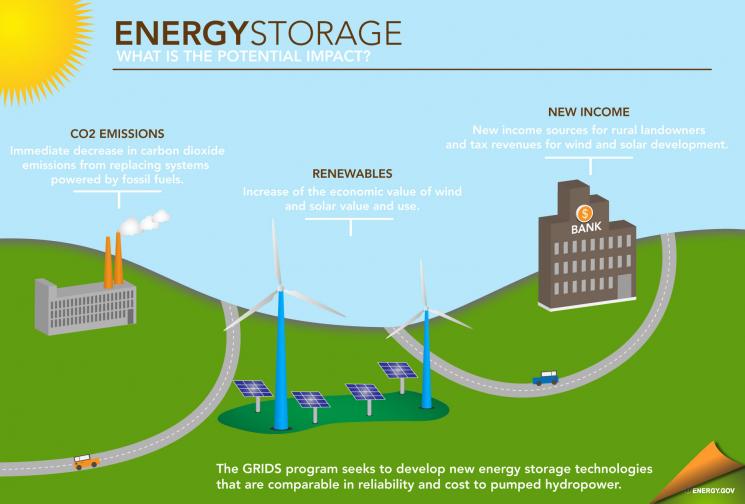
Improved energy storage technology offers a number of economic and environmental benefits.
Energy storage isn’t just for AA batteries any more. Thanks to investments from the Department's Advanced Research Projects Agency-Energy (ARPA-E), energy storage may soon play a bigger part in our electricity grid, and help enable the increased generation of renewable electricity.
Producing renewable electricity is most commonly associated with wind and solar power. Although these power sources are clean and renewable sources of electricity, they can also be unreliable since they don’t produce any power when it gets dark or the wind stops blowing. As these power sources become more important to our energy economy, so does investment in technologies that allow energy producers, such as utilities, to store energy that is generated when the sun shines and the wind blows. This stored energy can then be released as needed, providing a continuous flow of clean energy during periods of high demand or when wind and solar energy is unavailable.
Today’s electricity grid -- the interconnected network that delivers electricity from suppliers to consumers -- has virtually no storage. The storage facilities that do exist use pumped hydropower, a system that pumps water uphill to a reservoir when excess electricity is available and then lets the water flow downhill through turbines to generate electricity when it is needed. While pumped hydropower storage works well, it can only be located in very limited areas of the country. The 12 ARPA-E projects that make up the Grid-Scale Rampable Intermittent Dispatchable Storage (GRIDS) program are aimed at developing new energy storage technologies that are comparable in reliability and cost to pumped hydropower, and are deployable at any location in the country. These new technologies could enable the storage of vast amounts of electricity anywhere on the grid across the country. Improved methods for storing and dispatching electricity would enable the increased use of renewable electricity generation while maintaining high reliability in electric supply.
Beyond enabling the increased use of renewable electricity generation, improved energy storage technologies have several benefits:
- Security: A more efficient grid that is more resistant to disruptions.
- Environment: Decreased carbon dioxide emissions from a greater use of clean electricity.
- Economy: Increase in the economic value of wind and solar power and strengthened U.S. competitiveness in the clean energy race.
- Jobs: New income sources for rural landowners and tax revenues for wind and solar development areas. More jobs in supporting sectors such as manufacturing, engineering, construction, transportation and finance.
Check out the infographic above to see how energy storage projects are revolutionizing the grid, and see energy storage projects up close at ARPA-E’s 2012 Energy Innovation Summit, held February 27-29 right outside Washington, D.C. For more information, visit http://energyinnovationsummit.com/.





